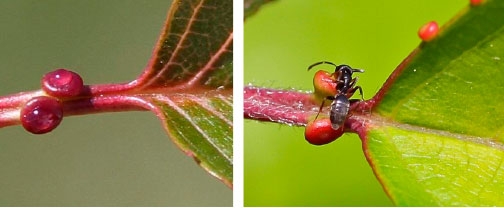Many plants (for example cherry), have nectar–secreting plant glands that develop outside flowers and are not involved in pollination.
These glands are called extrafloral nectaries or EFN.
EFN can occur on leaves, plant stalks (petioles), plant stems, fruits and virtually any other above-ground plant part.
EFN can look quite different in different plant species. They can range from single-celled trichomes (plant hairs) to complex cup-like structures.
The purpose of EFN
What is the purpose of the nectar produced in EFN?
Nature is always looking for a payback: you do something for me and I'll pay you back with this.
So the plants secrete nectar to attract predatory insects (such as ants or wasps) which will not only drink the nectar but will eat plant-eating insects as well.
Hence the plant recruits its own personal army of bodyguards which are fed with nectar, and in return they defend the plant against harmful insects
This nectar is the currency used by plants to pay insects and other animals to do their bidding.
It costs plants little to photosynthesise this sweet medium of exchange. They use energy from sunlight to rearrange the elements provided by water and carbon dioxide.
A recent rise in awareness of the importance of pollinators has highlighted this nectar-based economy.
Few people are aware that extrafloral nectaries—nectar–producing glands physically apart from the flower—have been identified in at least 2000 plant species in more than 64 families.
EFN of Prunus
You may be aware of the EFN found on the leaf petioles of cherry, peach and nectarine (the genus Prunus).
The EFN have been used to help identify plants in this genus, especially cherries. The glands first served only as a taxonomic feature—before research revealed their ecological function.
The EFN on cherries and other Prunus species can vary considerably in size and shape from species to species.
Some EFN appear as small red or green bumps or dots on the petiole at the base of the blade, while others look like well-defined pinkish red to deep red donuts.
Plants utilise EFN
We have discussed ants affecting plants negatively one way or another: taking nectar from flowers but failing to fertilise the plant; farming scale-insects and aphids, and defending them from their predators.
Ants, however, also have a mutualistic relationship with plants.
Take the cherry tree. As green cherries are growing, their young tender leaves are at their juiciest. Many caterpillars and other herbivorous insects would love to eat them.
(cont next month)
See this article in Tree Fruit July 2018




















